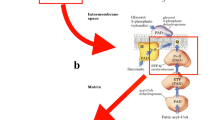Summary
A new case of neonatal glutaric aciduria type II is reported. Neonatal acidosis, hypoglycemia, and hyperammonemia were characteristic. The baby died at four days of age. Organic acid analysis revealed massive glutaric aciduria with elevated concentrations of butyric, isobutyric, n-butyric, and isovaleric acid in his urine. The baby's pedigree suggested strongly an X-linked recessive mode of inheritance. Clinically, biochemically, and genetically glutaric aciduria type II is an heterogeneous disorder. The neonatal form is an X-linked inherited disorder which presents early in life, and is associated with metabolic acidosis, hypoglycemia, and hyperammonemia, and leads to death in the neonatal period. The mild form is an autosomal recessive inherited disease which may present even in adults, and is associated with recurrent hypoglycemia without ketosis and usually improves. Nevertheless the same unusual organic acid pattern is observed in both forms. The basic biochemical defect must be distinct and has not been elucidated.
Similar content being viewed by others
References
Chalmers RA, Watts RWE (1972) The quantitative extraction and gas liquid chromatography determination of organic acids in urine. Analyst 97:958–967
Dusheiko G, Kew MC, Joffe BI, Lewin JR, Path FF, Mantagos S, Tanaka K (1979) Recurrent hypoglycemia associated with glutaric aciduria type II. N Engl J Med 301:1405–1409
Goodman SI, Markey SP, Moe PB, Miles BS, Tenb CC (1975) Glutaric aciduria: a new disorder of amino acid metabolism. Biochem Med 12:12–21
Goodman SI, McCabe ERB, Fennessey PV, Mace JW (1980) Multiple acyl-CoA dehydrogenase deficiency (glutaric aciduria type II) with transient hypersarcosinemia and sarcosinuria; possible inherited deficiency of an electron transfer flavoprotein. Pediatr Res 14:12–17
Gregersen N, Koloraa S, Rasmussen K, Christensen E, Brandt NJ, Ebbesen F, Hansen FH (1980) Biochemical studies in a patient with defects in the metabolism of acyl-CoA and sarcosine: another possible case of glutaric aciduria type II. J Inherited Metab Dis 3:67–72
Hall C (1978) Acyl-CoA dehydrogenases and electron-transferring flavoprotein. Methods Enzymol 53:502–509
Mantagos S, Genel M, Tanaka K (1979) Ethylmalonic-adipic aciduria: in vivo and in vitro studies indicating deficiency of activities of multiple acyl-CoA dehydrogenases. J Clin Invest 64:1580–1589
Przyrembel H, Wendel H, Becker K, Bremer HJ, Bruinvis L, Ketting S, Wadman SK (1976) Glutaric aciduria type II: report on a previously undescribed metabolic disorder. Clin Chim Acta 66:227–239
Rhead W, Mantagos S, Tanaka K (1980) Glutaric aciduria type II: in vitro studies on substrate oxidation, acyl-CoA dehydrogenases and electron-transferring flavoprotein in cultured skin fibroblasts. Pediatr Res 14:1339–1342
Ruzicka F, Beinert H (1977) A new iron-sulfur flavoprotein of the respiratory chain. J Biol Chem 252:8440–8451
Sweatman L, Nyhan WL, Trauner DA, Merritt TA (1980) Gluraric aciduria type II. J Pediatr 96:1020–1026
Author information
Authors and Affiliations
Rights and permissions
About this article
Cite this article
Coude, F.X., Ogier, H., Charpentier, C. et al. Neonatal glutaric aciduria type II: An X-linked recessive inherited disorder. Hum Genet 59, 263–265 (1981). https://doi.org/10.1007/BF00283677
Received:
Issue Date:
DOI: https://doi.org/10.1007/BF00283677




